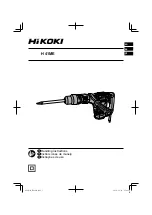
5
4) Power tool use and care
a) Do not force the power tool. Use the correct power tool for your application.
The correct
power tool will do the job better and safer at the rate for which it was designed.
b) Do not(use the power tool if the switch does not turn it on and off.
Any power tool that
cannot be controlled with the switch is dangerous and must be repaired.
c) Disconnect the plug from the power source before making any adjustments, changing
accessories, or storing power tools.
Such preventive safety measures reduce the risk of starting
the power tool accidentally.
d) Store idle power tools out of the reach of children and do not allow persons unfamiliar
with the power tool or these instructions to operate the power tool.
Power tools are
dangerous in the hands of untrained users.
e) Maintain power tools. Check for misalignment or binding of moving parts, breakage of
parts and any other condition that may affect the power tool’s operation. If damaged, have
the power tool repaired before use.
Many accidents are caused by poorly maintained power
tools.
f) Keep cutting tools sharp and clean.
Properly maintained cutting tools with sharp cutting
edges are less likely to bind and are easier to control;
g) Use the power tool, accessories and tool bits etc., in accordance with these instructions,
taking into account the working conditions and the work to be performed.
Use of the power
tool for operations different from intended could result in a hazardous situation.
5) Service
a) Have your power tool serviced by a qualified repair person using only identical
replacement parts.
This will ensure that the safety of the power tool is maintained.
Special requirements for rotary hammer
1.
Wear ear protectors.
Exposure to noise can cause hearing loss.
2.
Use auxiliary handles, if supplied with the tool.
Loss of control can cause personal injury.
3.
Hold Power tool by insulated gripping surfaces, when performing an operation where the
cutting accessory may contact hidden wiring or its own cord.
Cutting accessory contacting a
“live” wire may make exposed metal parts of the power tool “live” and could give the operator an
electric shock.
4.
Wear a dust mask
.
Do not inhale the harmful dusts generated in drilling or chiseling operation.
The dust can endanger the health of yourself and bystanders.
5.
Before beginning work, check the working area (e.g. with a metal detector) to ensure that no
concealed electric cables or gas and water pipes are present.
Contact with electric lines can lead
to fire and electric shock. Damaging a gas line can lead to explosion. Penetrating a water line
causes property damage or may cause an electric shock.
6.
If the supply cord of this power tool is damaged, it must be replaced by a specially prepared cord
available through the service organization.
7.
Do not touch the bit during or immediately after operation. The bit becomes very hot during
operation and could cause serious burns.
8.
Do not use the power tool with a damaged cord. Do not touch the damaged cord and pill the
plug from the outlet when the cord is damaged while working.
Damaged cords increase the risk
of an electric shock.
Warning:
Reduce the working time to avoid risks related with too much vibration.
Содержание SR610-35MA
Страница 2: ...4 12 11 12 11 10 12 11 ...
Страница 15: ...4 12 11 12 11 10 12 11 ...
Страница 27: ...2 1 2 3 4 5 6 7 8 9 10 ...
Страница 38: ...2 1 2 3 4 5 6 7 8 9 10 ...





































